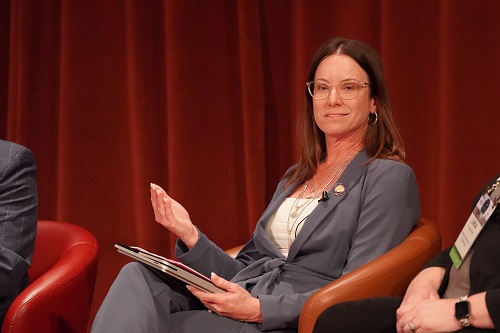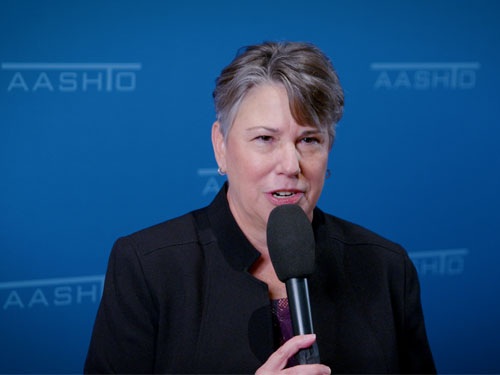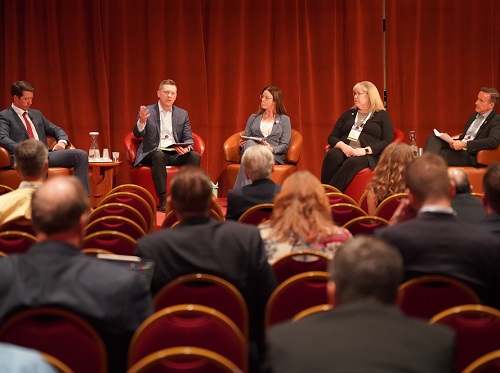Leadership is perhaps the key part of any communication strategy designed to deal with either planned or unplanned transportation events, according participants in a knowledge session held during the American Association of State Highway and Transportation Officials 2024 Spring Meeting in Madison, WI.
[Above photo by the Wisconsin DOT]
Moderated by Scott Culliane, enterprise account manager for drone-maker Skydio, the knowledge session’s panelists detailed the key pieces of communication strategies for state departments of transportation when facing “known” events, such as how NFL games or solar eclipses can impact traffic flow, to “unknown” events, such as bridge collapses and natural disasters.

“In terms of our response to any incident, whatever that may be – whether it’s a natural disaster, whether it’s a traffic crash, whether it’s a global pandemic or whatever the case may be – the first principle is to show up,” explained Scott Marler, director of the Iowa Department of Transportation.
“Now this sounds simple, but it’s not always simple,” he added. “Sometimes it is about saying, ‘we’re here, we don’t have all the answers right this moment, but we’re going to figure this out, and we’re going to work together to get through it.’ Yet the showing up part – and by showing up, I mean physically being there, being present at the scene of whatever the issue is – makes a huge difference. That’s really half the battle right there.”
Marler noted that other key leadership principles in such situations include giving permission to teams to close gaps in any problem by “saying it’s OK, let’s go for it” when solutions are offered.
“Also, when you think you’ve communicated enough, do it again,” he said. “It is really a simple formula: ‘Here’s what we know and here’s what we’re doing.’ If you get those two things across in simple, clear terms, you will have almost won the battle right there in your communication strategy.”

Kim Holland, assistant secretary of strategic development for the Florida Department of Transportation, emphasized that communication channels are just as critical between state DOTs and local governments, law enforcement agencies, and others even during planned or “known” events.
“When we know those events are going to happen, we will be planning for them at least a year in advance; we’ll set up special committees that will work with all of our local partners to address needs, such as additional transit, traffic monitoring through our cameras, and how to communicate to people so they can get around,” she said.
Holland stressed that even with “known” events, the unexpected arises. “A few years back Jacksonville hosted the Super Bowl, yet in that [city] space there almost wasn’t enough room for even hotels,” she said. “They actually brought in cruise ships that served as hotels during that time. So each event can be very unique, depending on where in the state it’s happening; and we need to adjust through that situation.”
Linda Wilson Horn, communications director for the Missouri Department of Transportation, also stressed that “known” events – even those years in advance – can also create challenging situations for state DOTs, which is why examining similar events from the past can help generate better solutions for future ones.

“When the Solar Eclipse came through the United States in 2017, I thought, ‘yeah, big deal, what’s the big deal with this?’ And then we started getting information about the last time a solar eclipse went through Europe, creating six, eight and 10 hour traffic jams from people leaving the areas of totality,” she said.
As a result, state DOTs in the direct path of the eclipse – from Oregon through South Carolina – set up a special working group through the AASHTO Committee on Communications to address the messaging around this solar event.
“Challenges we faced were, ‘Who is our audience? What do we need to tell them?’ And specifically, ‘what do we need to tell them from a transportation perspective?’ Because you know, when you hear about the eclipse, it’s the scientists who are geeking out about it and making sure you wear the right glasses,” Horn said. “But nobody’s really talking about the traffic.”
Traffic congestion was only one of the many issues facing Scott Higley, director of strategic communications for the Georgia Department of Transportation, when an arsonist triggered a massive fire under key north/south I-85 highway bridges in March 2017 – causing one to completely collapse.
Higley went through a detailed step-by-step timeline of the fire, resulting damage, debris removal, and eventual restoration of the bridges in just six weeks. From a communications perspective, he explained that having inter-agency communication channels set up prior to the event proved helpful, especially in terms of keeping everyone on the same page in terms of the day-to-day recovery operation.

“We think of communications as largely external, but internal has to come first and – in a crisis – your internal communications have got to be top notch, as do interagency communications,” he stressed.
“In our particular case, if internal communications aren’t right, then nothing else will be right after it. Your external efforts will fall apart, so I urge you to always make sure that communications has a seat at the table in these areas – for after the fact is too late,” he noted.
Higley said one of the key strategies Georgia DOT deployed was getting all of the relevant agencies and communication teams in one room at the same time to get updates on the situation.
“We have to hear it in real time – and that’s one of the things that I’m so proud of with our effort,” he said. “Everybody was in the room, all of the relevant divisions and offices and people within Georgia DOT, but also the other agencies involved, the heads of our regional and local transit agencies, law enforcement, Georgia State Patrol, Atlanta Fire. They were all there. And everybody gets to hear it at the same time.”
Higley added that building external communication relationships proved important as well. “Don’t wait until the crisis comes along. Foster those relationships early. It is too late in a crisis to try to introduce yourself to someone. There’s no time for that,” he said.
Finally, Higley stressed that “doing nothing” especially in a crisis situation must be avoided. “This is not a time for ‘analysis paralysis.’ One of the things that I have so much respect for with our leadership and our commissioner [Russell McMurry] is that he empowered us to make the decisions that we know are right in the moment,” he said. “And if we had to go back and make corrections, that’s OK, we’ll do that. Mistakes can be made. But doing nothing is not the answer.”
 Top Stories
Top Stories
USDOT Makes $1.5B Worth of BUILD Grants Available
December 19, 2025 Top Stories
Top Stories

